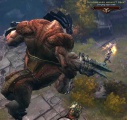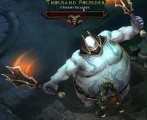Boss
Bosses in the Diablo games come in various shapes and forms. From the randomly generated mini-bosses on a level to Superunique big quest boss like Diablo, they are all bosses of some description.
See also:
Contents
Diablo III Bosses
What's known about the Diablo 3 bosses comes almost entirely from player observations during the Blizzcon 2008 and 2009 demos. This information is subject to change, and may be biased, since it's known that Blizzard turned up the monster rates and item drop rates in the demos, in order to make them more fast paced, exciting, and new-player-friendly.
The organizational system of bosses in Diablo 3 is much as it was in Diablo 2. There are numerous Champions and random bosses scattered around the game world, while SuperUniques are rarer, and usually set in special, scripted locations or as part of larger encounters. Scripted events and special scenarios seem to be much more common in Diablo 3 than it they were in Diablo 2.
Scripted events such as the ones that led to battles against massive bosses in the WWI 2008 gameplay movie (Siegebreaker and Thousand Pounder) have not been included in the playable Blizzcon builds, aside from the dungeon ending in the battle with the Skeleton King in the 2008 Blizzcon demo. Players have seen more random bosses and champions, and these have been much as they were in Diablo 2.
That said, the developers are clearly holding back the good stuff and not letting fans see any of the bigger encounters at this early stage in the game's development.
Bossmonsters per act
Act I
Skeleton king. Araneae. The Warden. Butcher.
Act II
Act III
Ghom. Siegebreaker Assault Beast. Cydaea. Azmodan.
Act IV
Boss Names
The free-range boss monsters in Diablo 3 have randomly-assigned names that are fairly similar to the names they had in Diablo and Diablo 2. A few samples noted from Blizzcon 2009.
- Death Froth -- Sand Wasp.
- Spirit Hawk -- Lacuni Warrior.
- Bile Feast -- Lacuni Warrior.
- Rust Raven -- Lacuni Warrior.
- Haze Fuse -- Tomb Viper.
- Pit Thorn -- Tomb Viper.
There will also be plenty of superuniques and other high level bosses with have fixed names, who will appear in the same place each game, whether they're part of the plot or just localized events. Only a few of these are known thus far, but you can read about Thousand Pounder, Siegebreaker, and the Skeleton King for more details.
Lengthy Boss Battles
One thing the developers have talked about is their goal to create larger, multi-stage, more impressive battles in Diablo 3. They aren't going to be happy with just one big boss players must spend lots of time spent whacking away at. They want the big fights to involve more variety and difficulty, and this was seen to some extent in the way that the Skeleton King kept resurrecting more skeletons during his battle, at the end of the 2008 Blizzcon demo.
This issue was discussed by Kevin Martens and Julian Love during an interview at Blizzcon 2009. [1]
- Diii.net: I’m curious to hear more about the big bosses in the game. The only one that’s been seen is the Siegebreaker, and Jay Wilson said that he wasn’t even an Act Boss. So what does an act boss look like? What will an encounter of that sort be like for players?
- Kevin: Players will know they’re up against a big boss when they have to change their gameplay style. You won’t be able to just charge in and keep using the same tactics you use against a group of Fallen. You have to be more careful against a big boss. A tank character can’t just stand and tank as he’s used to. New strategy will be required. We want to make bosses interesting and powerful. They should be a challenge and be varied in what they require of all classes and abilities, as well as from parties. We want to make bosses more interesting than in the previous Diablo games. We look forward to showing them off, but we can’t talk about any specifics yet.
- Diii.net: When Siegebreaker dies in the WWI gameplay movie, he spawns about a thousand skeletons from his corpse. Is that the sort of thing we’ll see from big bosses? Multi-stage events?
- Kevin: Some may be multistage. Some don’t need to be that way. It depends on the boss, the stage, the player level, etc. We require different tactics to keep it interesting. We can’t pre-plan everything at this stage, since we don’t know what range of levels the players will be when they reach the boss. And we need to consider how to keep the boss fun through additional encounters. So the third or tenth time a player fights the boss, it’s still fun and exciting.
- Julian: We also want to use bosses to move the story forward. We have story-based elements to vary the bosses. For one thing, we gave the bosses different ways to kill players.
- Diii.net: Like when Siegebreaker bites off the Barbarian’s head?
- Julian: That’s his way of killing players, but that’s not the only way a boss can finish off a player.
To assist players in these long, treacherous battles, boss monsters will periodically drop health globes during the fight. [2]
- Jay Wilson: ...we deal with some of the harder monsters, like bosses and rares and champions ...they would drop health globes at percentages of their health. Rares in particular are almost guaranteed to drop about every 25%. The other thing we did, because we design everything for cooperative play, if you pick up a health globe and you have a friend nearby, you both get the benefit. So that's something we did to make sure the system didn't favor people who are running forward, melee classes, who used to pull up all the health potions. Now they're actually helping the people in the back.
Boss Modifiers
As in Diablo II, many bosses have special modifiers, giving them elemental attacks, teleportation, the ability to heal, the ability to duplicate themselves, and many others.
See the Boss Modifiers article for full details.
Boss Images
A few screenshots of bosses, each of which is detailed on their own wiki pages.
Diablo, Lord of Terror.
| Monsters of Diablo III[e] Beasts Beasts: Superunique Demons Demons: Superunique Humans Humans: Superunique Undead Undead: Superunique Objects Bosses Boss Mods Monster Info Fanmade |
|---|
| Beasts | Bat - Beast - Blood Hawk - Demonic Hellflyer - Electric Eel - Khazra - Lacuni - Lamprey - Quill Fiend - Rockworm - Sand Monster - Sand Shark - Sand Wasp - Scavenger - Spider - Spiderling - Swarm - Withermoth - Wood Wraith - |
|---|
| Demons |
Armored Destroyer - Dark Berserker - Deceiver - Fallen - Ghoul - Hellion - Thrall |
|---|
| Undead |
Accursed - Bone Reaver - Brigand - Dune Dervish - Ghost - Ghoul - Grotesque - Morlu Caster - Risen Dead - Skeleton - Skeleton Mage - Unburied - Wraith - Wretched Mother |
|---|
| Primary Quest Uniques |
Act One Bosses:
Araneae -
Skeleton King -
The Warden -
The Butcher
|
|---|
|
| |||||
|---|---|---|---|---|---|
| Uniques Modifiers |
Strong CC (Limit 1): Knockback -- Nightmarish -- Vortex -- Jailer | ||||
| Removed Modifiers |
| ||||
|
| |||||
| Act One Uniques | Araneae - Web Spit | Leoric - Summon Skeleton, Teleport Strike, Triple Cleave | The Butcher - Smash, Grappling Hook, Spear, Frenzy Charge | ||
| Act Two Uniques | Maghda - Forcefield, Summoning Ritual, Punish, Moth Dust, Teleport. | Zoltan Kulle - Fiery Boulder, Time Bubble, Ceiling Collapse, Energy Twister,Vanish, Creepy Laugh | Belial - Phase One: Triple Fireball, Summon Vipers. Phase Two: Poison Meteors, Ground Pound, Lightning Strike, Lightning Breath. | ||
| Act Three Uniques | Ghom - Acid Slime, Sneeze, Gas Cloud, Chomp. | Siegebreaker - Triple Hit, Charge, Leg Stomp, Grab and Throw. | Cydaea - Pain Bolts, Web Trap, Spider Pits. | Azmodan - Bellyflop, Laser Attack, Falling Corpses, Demon Gate, Pool of Destruction, Globe of Annihilation. | |
| Act Four Uniques | Rakanoth - Cleave, Teleport Strike, Blade Strike, Volley, Summon Minion. | Izual - Frost Nova, Frozen, Summon Minions. | Diablo - Phase One: Claw Rip, Charge, Hell Spikes, Shadow Vanish Grab, Curse of Destruction, Ring of Fire, Ground Stomp, Curse of Anguish, Curse of Hatred. Phase Two: Shadow Clone. Phase Three: Overdrive, Lightning Breath. | ||
| Monster Info |
Monsters Basics -
Bosses -
Boss Modifiers -
Champions -
Quest bosses -
Teeth of Diablo -
Fan-made monsters
|
|---|



